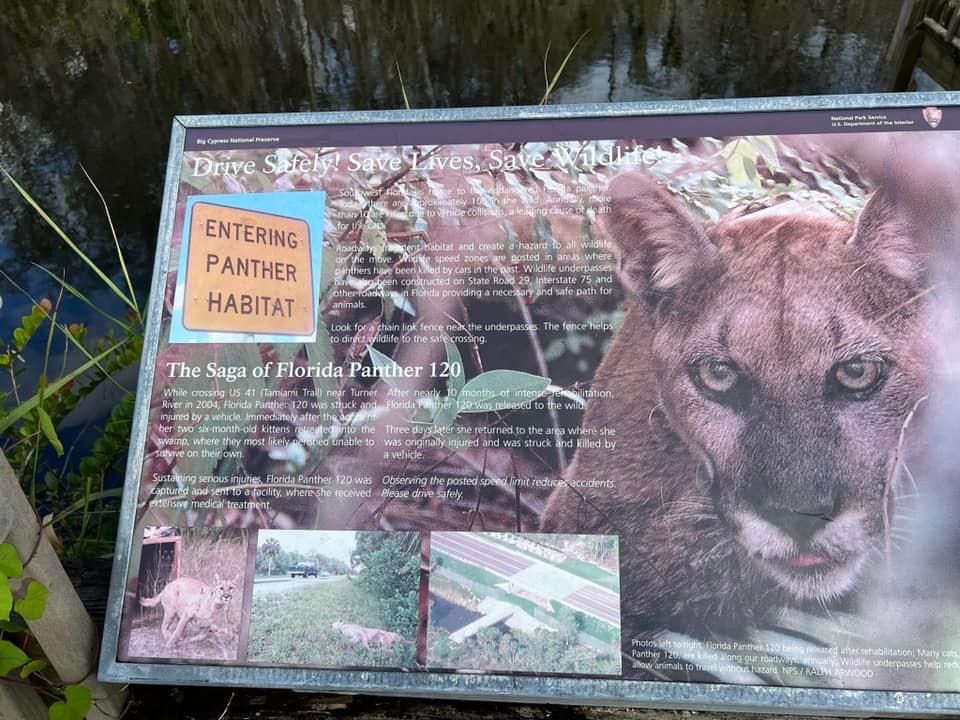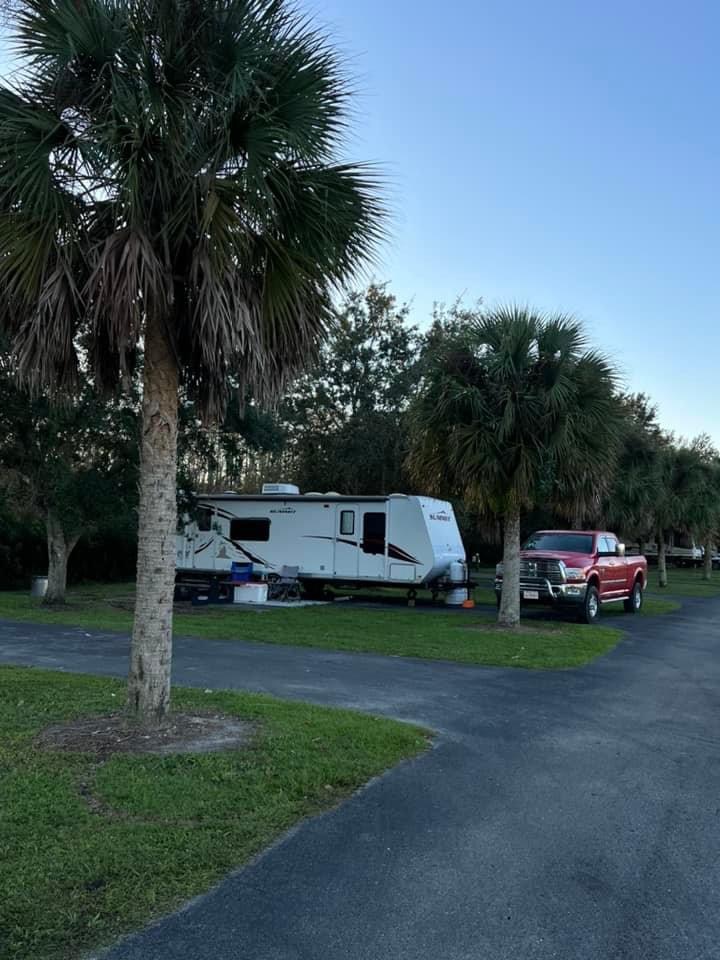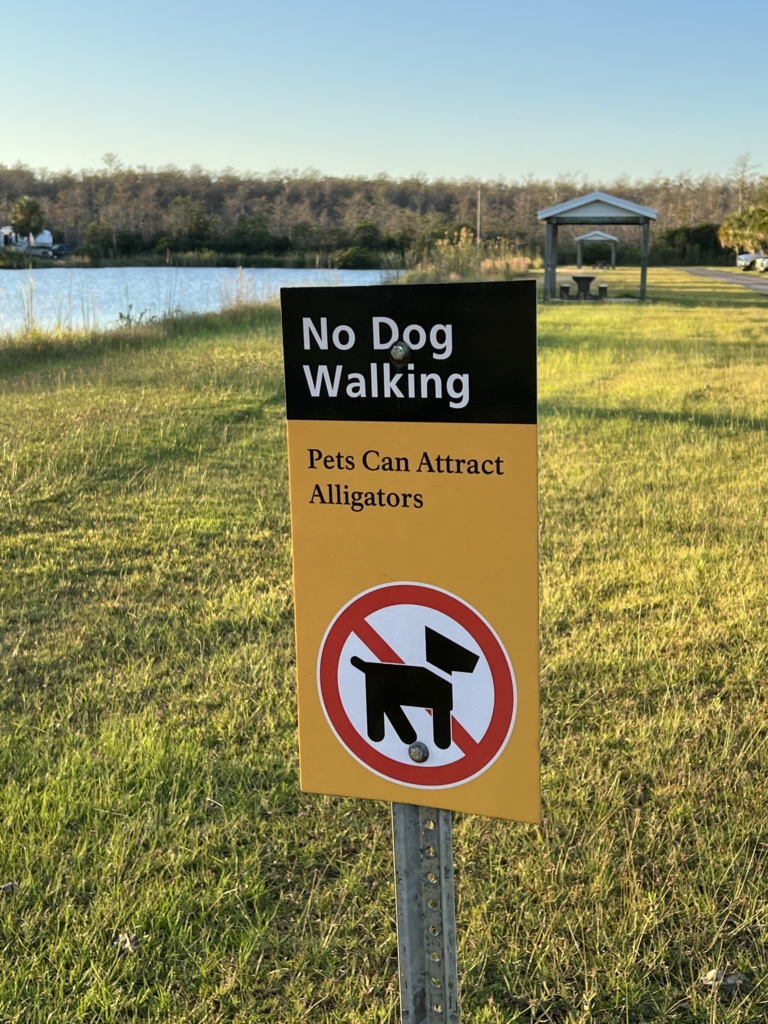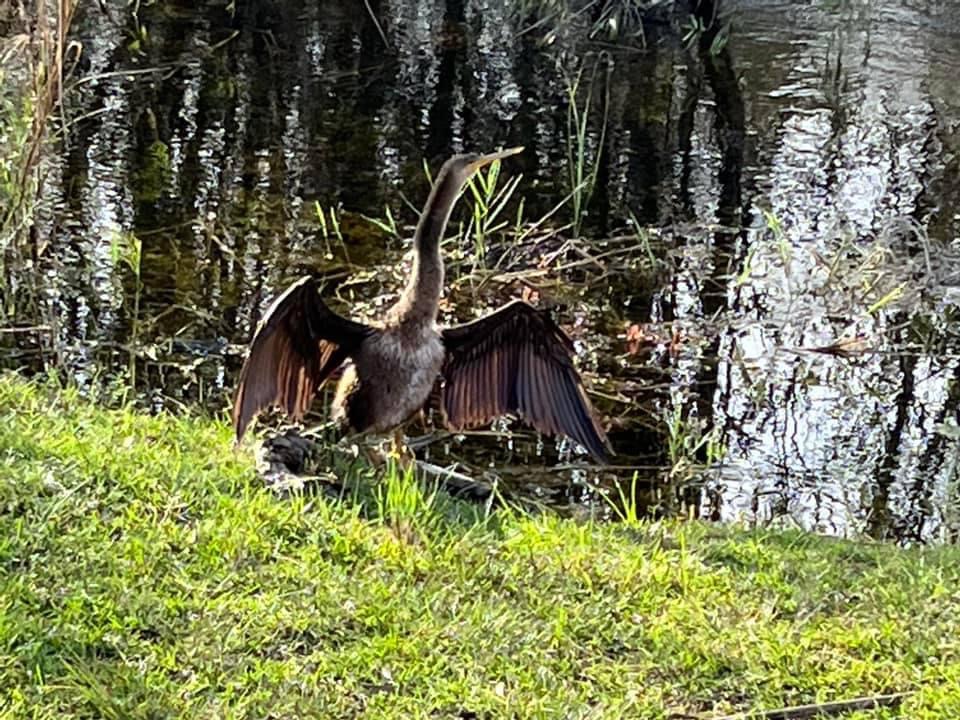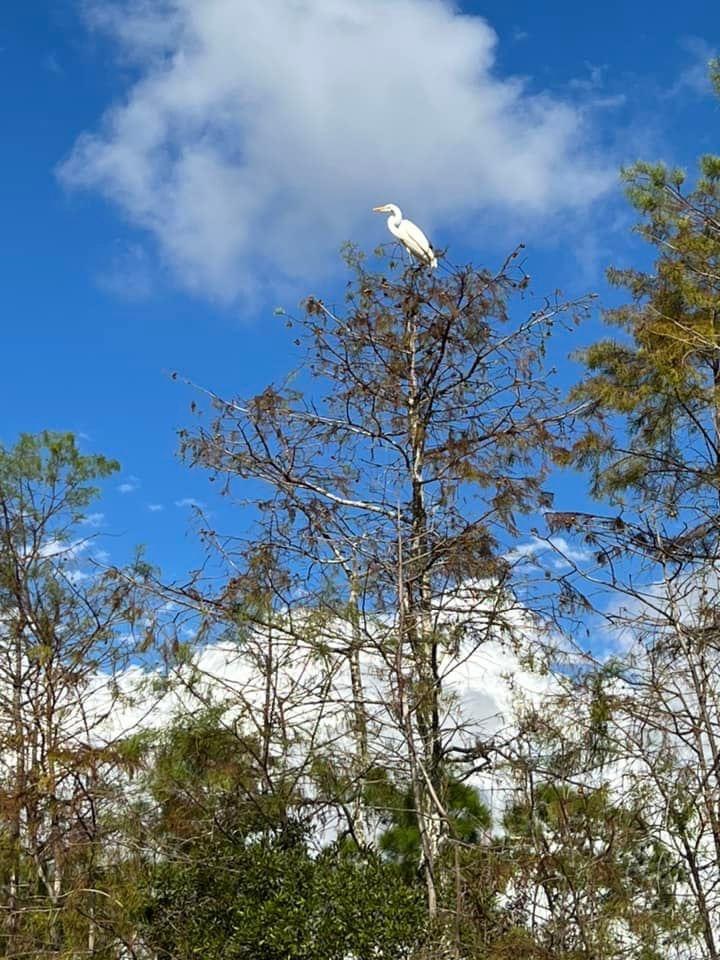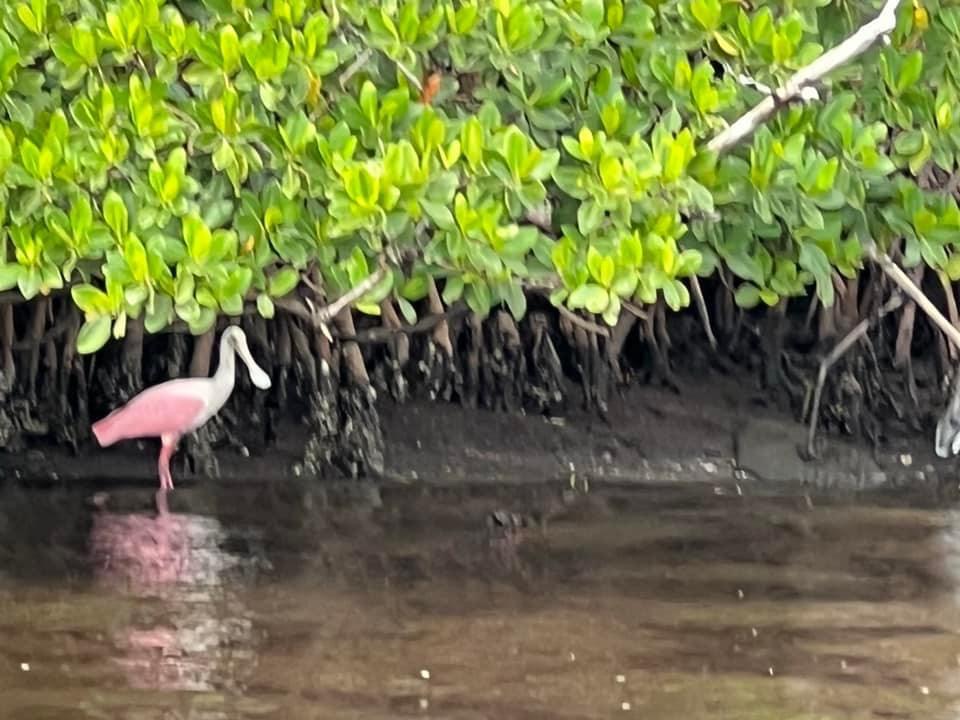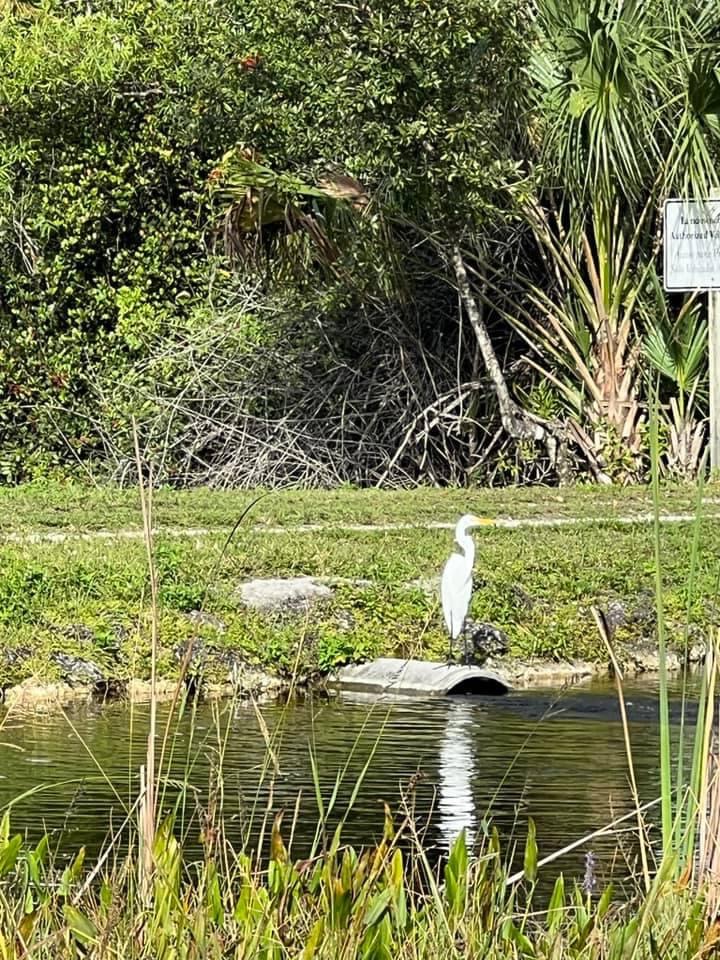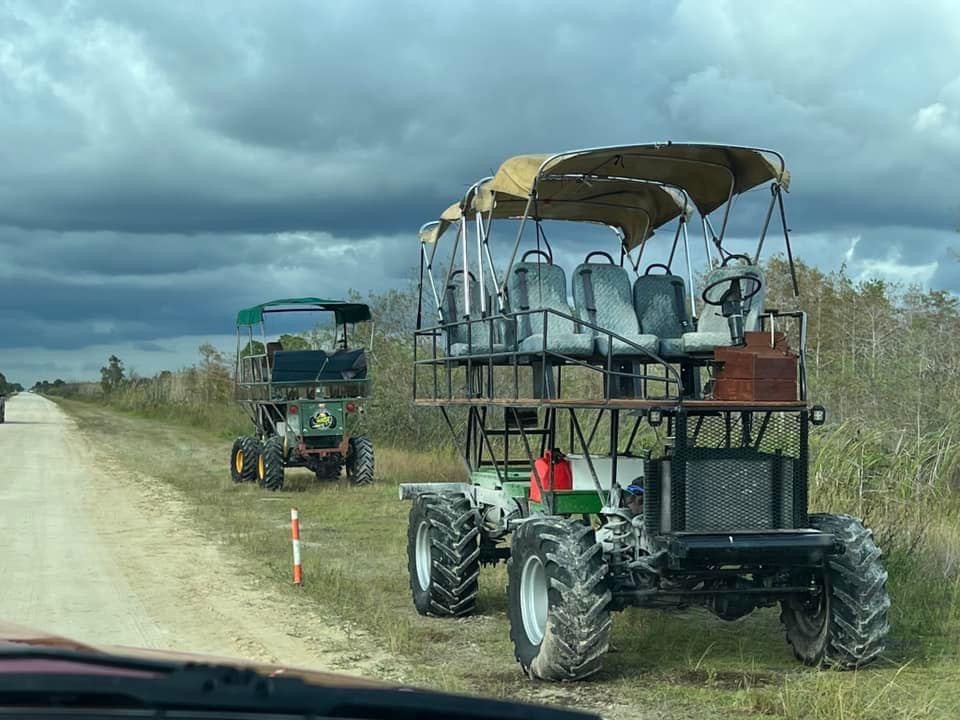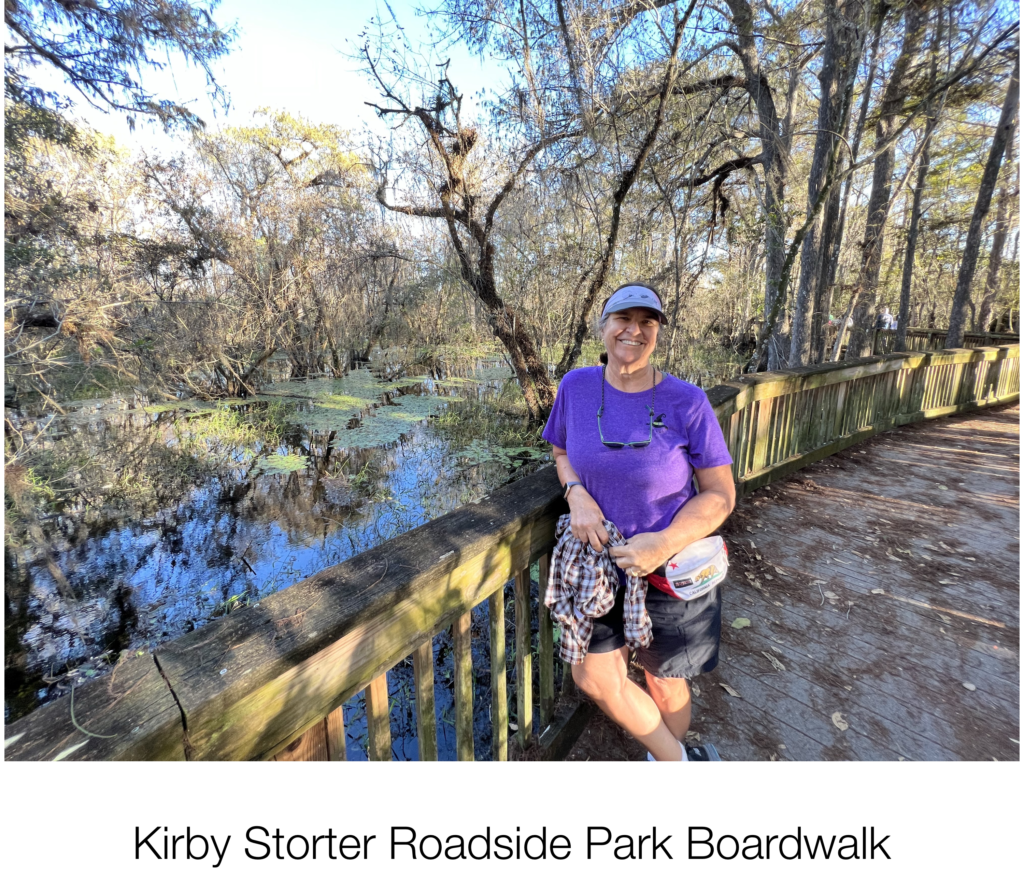IF YOU ARE READING THIS IN AN EMAIL, CLICK ON THE HYPERTEXT TITLE ABOVE TO READ IT IN BIGGER PRINT.
(Note: This blog entry represents a combination of writings and pictures already posted about our Cool Change II, Land Yacht Adventures 2021 through Cindy via Facebook and Rick via email. So for some of you, the following posts may be duplicative, but for others, this is the first time you are seeing them. We are repeating them here to centralize the record and share our experiences more broadly.)
RICK’S POST, with additional photos and captions by Cindy:
We had been looking forward to visiting our next destination, the Florida Everglades. We loved our time spent in the Florida Keys but it was time to move on. We said our goodbyes to the people we had met at Royal Palms RV Park and got a leisurely start, knowing we had just 153 miles to travel that day. Only minutes after leaving Royal Palms, the check engine warning light illuminated on the truck instrument panel. To make matters worse, we had just got on one of the many bridges connecting the islands of the Keys and there was really no good place to pull over to investigate for several miles.
The truck seemed to be running fine and none of the other gauges indicated that there were any problems. I asked Cindy to look up what it said in our owners’ manual about that light and what she found didn’t seem to indicate anything serious, at least for the moment. It said that if the light illuminates it could have several causes and only if it did not go out after several different engine start and stop cycles, should you then need to bring the truck in for service and have it investigated. I was thinking that our issue may have been fuel related, or more likely due to several days of driving at speeds of less than 40mph, as is the norm in the Keys. I was hoping the truck just needed a good run at freeway speeds to clear things up. For whatever reason, once we had completed our travel for the day, the next time I started the engine, the light remained off. Relief!
There is a sizable Native American presence in the Everglades. They are part of the Seminole and Miccosukee tribes, which were forced south by the US Military during the Seminole wars of 1835 – 1842. Right as we crossed over the southern border of the park, we found ourselves driving through reservation lands. We started seeing some signs advertising a restaurant called the Voodoo Grill that served alligator meat. It was owned and operated by a local tribe, and they also offered airboat tours. I had tried alligator at other times I visited in the south, but Cindy had not. So to satisfy her curiosity, we stopped and ordered two plates of alligator with fries. Most often, when you order alligator meat, it is going to be deep fried tail meat. This is because the tail has the most usable meat, and deep frying it is an easy way to prepare it without the meat being too tough. In finer restaurants, it may be grilled, stewed, or sautéed. As ours was from a roadside tourist diner, it was as expected, served fried. The texture was somewhere between chicken and fish and yes it mostly tastes like chicken!
We made our way to our campground called Big Cyprus National Park Midway Campground. As the name implies, it is inside of the Big Cyprus National Preserve that is smack in the middle of the Everglades. The campground was a bargain as have been all the National Parks we visited. Though already cheap, we got an additional 50% senior discount at all National Parks, which brought the charges down to just $15 per night, including water and electrical hookups. This campground has 26 paved RV sites that form a ring around a large alligator pond in the center.
There were several signs around the pond warning of the presence of alligators, forbidding swimming or walking dogs close to the water. I am not convinced there were any alligators here because we never saw any, but gators were numerous in some other places we would visit. The first night, a large Class A RV directly across the pond from us had their headlights on for about a half hour. I can only think they were trying to spot alligators on the water at night. If you shine a light on water where an alligator is floating, you will see the light reflected from their eyes as red dots.
In the morning we had reservations to go on an airboat ride in the swamp. From our campground it was located about a half hour drive west in Everglade City. There were probably a dozen or more companies we could have gone with but Cindy selected the one called “Everglades City Airboat Tours.” They claim to be the original airboat company in the area, but what attracted was that they advertised that the boats had headsets for the passengers and their tours were narrated by the airboat skipper.
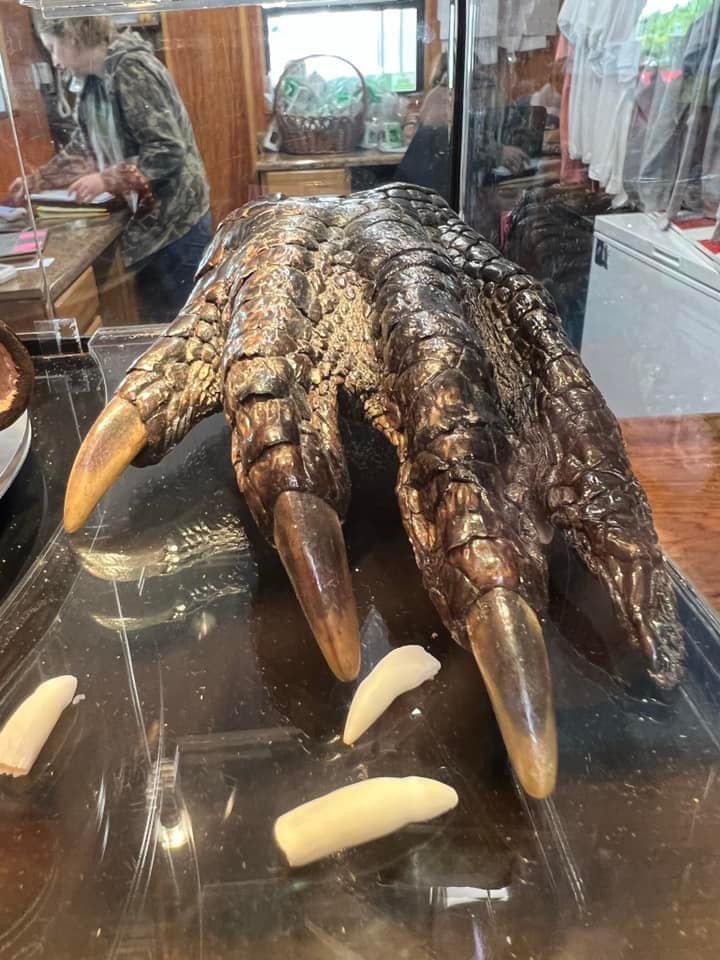
Our tour was one of the first trips of the morning, which worked out well for us as there was just us and one other couple on the boat. Cindy and I were both excited to see some gators in the wild, but on this trip that was not to be. The departure area was a 5mph zone for several hundred yards in any direction. Our skipper explained that this was because it was a Manatee zone. Manatees are an endangered species and many of them are killed each year, run down by boats. That used to be the biggest threat to the Manatees but now they have a bigger problem: it is estimated there are fewer than 6000 manatees in all of Floridas waters, and so far this year more than 1000 of them have died due to starvation. The manatees are vegetarians and their main source of food has always been seagrass. A Manatee can eat over 100 pounds of seagrass per day! The problem is that the seagrass has been dying off in drastic proportions over the last decade due to human-caused pollution related to the ongoing construction boom in Florida. An organization called The Harbor Branch Oceanographic Institute is experimenting with growing seagrass in tanks and transplanting it to the lagoons where much of the Manatee population lives.
Once we got out of the sensitive area, we took off into the canals that are cut out of the mangrove forests on the water. Often the mangroves would form a complete canopy over the waterway. The airboats reach speeds of 45 mph through the twisting canals and lagoons. The boat captains are all made aware of each others’ position by VHF radio communications to minimize risk of a collision. I believe that the canals are all designated for one way travel, which would only make sense as we never got in a situation where there was head-on traffic.
Although the skipper, Gary, did his best to find them, we never saw any alligators. This came as no surprise as with the number of airboats speeding through the mangroves, it just doesn’t feel like a place where gators would want to hang out and thrive. I think the airboat trips there are more about an amusement park style ride coupled with witnessing the beauty of the swamps. We did see lots of birds including Blue and White Herons, Cranes, Flamingos and Egret. One of the most unusual and beautiful birds we saw was a Roseate Spoonbill, which is a rose-colored wading bird with, as the name suggests, a bill shaped like a spoon. They walk through the shallow water and probe the mud with their bills for food.
We were floating along through one of the many lagoons along our route that our skipper told us was named “Wally’s Lagoon.” It was named for a former airboat captain named Wallace Weatherholt.
The story goes that in 2012, Wallace, or “Captain Wally” as he was known, was then a popular airboat captain working for a local company in Everglades City. One day he took a family of tourists into this very lagoon. There he found an alligator that was behaving very strangely, thrashing about and being quite aggressive. Most of the other guides stayed clear of this alligator, but Wally had brought along some fish with him, as he was known to do, and was entertaining the tourists by trying to feed the alligator. Normally, he would slap the water with the fish and an alligator would come to investigate. When an alligator got beside the boat, Wally held the fish a few inches above the water to coax the animal to make a lunge for the fish treat. What happened this day though, was that the gator got ahold of the fish along with Wally’s hand, and bit off his hand! He was somehow able to pilot the boat back to the dock before bleeding to death, and was rushed to the hospital.
Meanwhile the Florida Fish and Game department went out and found the alligator, killed it and recovered Wally’s hand. The hand was brought to the hospital where they attempted, but were unable to reattach it to Wally’s arm.
Feeding alligators in the wild is against the law and a problem in Florida that has lead to many injuries and deaths. A month after the incident, the authorities showed up at Wally’s home and arrested him. He was charged with a misdemeanor offense that carried a fine of up to $1,000 and six months’ jail time. It is really hard not to insert a pun here but I will refrain. The saddest part of this story is that entirely because of Wally’s actions, an alligator in the wild, needlessly lost its life and Wally lost his hand and career.
Though we had not yet seen any alligators in the Everglades, that was finally about to change. We were told of a viewing area just off the road (Highway 47) to our campground where we would likely see some gators. It is called HP Williams Roadside Park and consists of a large parking area and a boardwalk that is built along the swamp. Right away we saw several alligators lounging or moving slowly through the water. While we were there, another visitor told us that if we followed the unpaved road just past the parking area, it would take us on a 17 mile loop along the swamp and we would likely see lots of birds and gators. We took the advice and we were not disappointed. We saw at least a dozen alligators and many Egrets and other birds along the way.
A little farther along the highway back to our campground, we saw signs and took a look at the Turner River Canoe and Kayak Launch. There was a nice put-in area and there were several commercial vans and trailers supporting people boating on the river. It looked like it would be a really beautiful way to do some exploring but neither of us felt compelled to give it a try. Though I am sure the trips are very safe, we would much rather be in a kayak on whitewater than in a swamp with hungry gators and unfriendly water moccasins.
We went back and spent another night in our campground, and the person across the pond from us again had their headlights trained on the water for a time. I still did not think there were any alligators in that pond but I imagine that the people in that RV were having fun looking for them just the same!
In the morning I was sitting outside having some coffee and a man out for a walk stopped to say hello and introduce himself. Robert saw our California plates and told us that he and his wife Jenny were also from California: they lived in the city where Cindy had worked: Folsom! Robert and Cindy had mutual acquaintances through through the City of Folsom. This was just one of many small world experiences we had on this trip. Robert’s wife Jenny was definitely a little eccentric but seemed happy and full of life. They were on their way back to California after a cross-country trip to the Florida Keys. Robert has a cousin there who owns a home in Key West, as well as a small private island in the keys. They had spent a couple of weeks there and the route they were now taking home was similar to ours so we exchanged cell numbers in case we might meet up again along the way.
We were leaving that day, which happened to be the day before Thanksgiving. Some friends back home, Matt and Amy (Amy is my sister Elena’s oldest friend) had told us about an RV park in Fort Myer’s Beach in Florida called the Red Coconut. They discovered it on a previous trip to Florida and they said we should not miss it. When we made a reservation there for over Thanksgiving, the park staff told us that they would be serving Thanksgiving dinner in their clubhouse for everyone that wanted to join them so we told them to count us in. I mentioned this to Robert and he said they might just see if they could get in there as well as they were trying to decide on what to do for the holiday. We said our goodbyes and got on the road in the late morning with less than 100 miles to go to get to The Red Coconut RV Park in Fort Myer’s Beach.
As it would be an easy travel day, we weren’t in a big hurry so we had planned a few last stops on our way out of the Everglades. The first stop was the Clyde Butcher Big Cyprus Gallery. Clyde is to the Everglades what Ansel Adams was to Yosemite. He studied Ansel Adams’ work when he lived in California and early in his career as an architect. Some time around 1970, he lost his job and found that he could make a living selling his large format nature photography he had previously done as a hobby. He lived on a sailboat in Southern California for seven years until both his love of sailing and the television show Flipper drew him to move to Florida. He eventually purchased 14 acres of land in the Everglades, surrounded by a million acres of wilderness. We were amazed by the beauty of the Everglades that Clyde Butcher captured.
He started wading out into the swamps where he would take his large format, mostly black and white photographs, and became very successful with his art. The gallery is filled with his work and there is a nature walk out back where we hiked through some tall cedars along the banks of the swamp.
A little farther down the road is the Oasis Ranger Station and we stopped to visit there as well. They have some displays inside focusing on Everglades conservation projects but outside there was a long boardwalk along the swamp. That boardwalk was the main attraction. There were many healthy-looking alligators living there and they seemed very content with their habitat, well away from the noisy airboats!
Kirby Storter Roadside Park was another fun stop along our route. It has a mile long boardwalk over the swamp into a cypress forrest. It was beautiful scenery throughout and at the end of the boardwalk there is a large swimming hole that has been dug out by alligators as a place to hang out during the dryer parts of the year. We overheard a tour guide telling her guests that the cypress trees had been almost logged to extinction between the late 1800’s and 1930, as the trees were harvested for homes and the masts of sailing ships. The trees are now protected and part of the ecology that they are hoping to someday revive there.
Our last stop was at the site of the U.S.’s smallest post office. The building used to be an equipment shed on a local tomato farm that was pressed into service as a post office in 1953 when Ochopee’s general store and post office burned down. Since the. It has been in continual use as a post office and a Trailways bus lines ticket station. We were sad it was closed when we visited as it would have been fun to postmark some cards from that location to send to family and friends back home.


